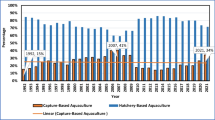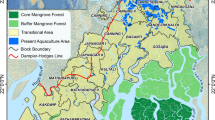Abstract
Using aquaculture as a post-mining land use has resulted in financial savings in site reclamation, increased positive media attention for coal companies, and new biosecure water sources for commercial aquaculture operations in the West Virginia coal region. Large underground coal mines in Appalachia have created numerous gravity flow sources of water. These mine water sources are often nearly ideal in temperature, alkalinity, and pH for trout and have the additional value of being devoid of any serious fish pathogens. At one site, modifying the post-mining land use permit to allow the water flowing from the portal of a closed mine to be used to produce commercial rainbow trout for the recreational market reduced site reclamation costs by nearly $450,000 (US). At another site, an acid mine water treatment plant was converted into a quality public fishing park with healthy warm water species (channel catfish, largemouth bass, and bluegill sunfish). The county park is now being used for educational and recreational purposes to the benefit of the whole community.



Similar content being viewed by others
References
Donovan JJ, Leavitt BR (2004) The future of mine water discharges from underground coal mines of the Pittsburgh Coal Basin, WV-PA. In: Proceedings of national meeting of the American society of mining and reclamation and the 25th West Virginia surface mine drainage task force meeting, Morgantown, WV. ASMR, Lexington, pp 518–528
D’Souza G, Miller D, Semmens K, Smith D (2004) Mine water aquaculture as an economic development strategy: linking coal mining, fish farming, water conservation and recreation. J Appl Aquac 15(1/2):159–172
Hulbert PJ (2000) Phosphorus reduction at Adirondack hatchery: is the end in sight? In: Proceedings of 3rd East Coast Trout management and culture workshop. American Fisheries Society, Southern Div Trout Committee
Jenkins MR, Wade EM, Fletcher JJ, Hankins JA (1995) Economic analysis of non-traditional water resources for aquaculture in West Virginia. The Conservation Fund’s Freshwater Institute, p 95
Kowalski DA, Bergersen EP (2003) The toxicity of Baylucide and TFM to Tubifex tubifex: implications for chemical control of the Oligochaete host of Myxobolus cerebralis, the causative agent of Whirling disease. N Am J Aquac 65(3):171–178
Miller D (2006) Trout culture as a post mining land use in West Virginia––a case study. Abstracts, Annual Meeting of the World Aquaculture Society, Florence, AQUA 2006, p 613
Mitchell AJ (2002) A copper sulfate-citric acid pond shoreline treatment to control the rams horn snail Planorbella trivolvis. N Am J Aquac 64(3):182–187
Modin JC, Veek TM (2002) Biological control of the parasitic copepod Salmoncola califoriensis in a commercial trout hatchery on the Lower Merced River, California. N Am J Aquac 64(2):122–128
Semmens KJ, Miller DJ (2003) Utilizing mine water for aquaculture. In: Proceedings of international water conference, Pittsburgh, IWC-03-24
Tierney AE (2002) The technical feasibility of using treated mine water to rear rainbow trout, Oncorhynchus Mykiss. MS Thesis, West Virginia University, Morgantown. https://eidr.wvu.edu/files/2575/tierney_aislinn_thesis.PDF
Viadero RC, Tierney AE (2004) Development of treated mine waters for aquaculture: non-ideal water chemistry effects at Dogwood Lakes. In: Proceedings of national meeting of the American society of mining and reclamation and the 25th West Virginia surface mine drainage task force meeting, Morgantown, WV. ASMR, Lexington, p 1960
Westers H (2000) The case of Michigan’s Platte River salmon hatchery––a fourteen year dispute about phosphorus effluent contribution and its impact on Platte Lake: a precedence for public fish hatcheries? In: Proceedings of 3rd East Coast Trout management and culture workshop. American Fisheries Society, Southern Division Trout Committee
Wolkersdorfer C (2008) Water management at abandoned flooded underground mines––fundamentals––tracer tests––modelling––water treatment. Springer, Heidelberg, p 466
Author information
Authors and Affiliations
Corresponding author
Rights and permissions
About this article
Cite this article
Miller, D. Using Aquaculture as a Post-mining Land Use in West Virginia. Mine Water Environ 27, 122–126 (2008). https://doi.org/10.1007/s10230-008-0038-4
Received:
Accepted:
Published:
Issue Date:
DOI: https://doi.org/10.1007/s10230-008-0038-4




